Designer rice could be the answer to global health problems such as obesity and diabetes, and improve health outcomes for more than half of the world’s population.
University of Tasmania School of Biological Sciences Professor Steven Smith is an expert on starch production in plants, and has discovered a way to increase the production of resistant starch in rice.
Professor Smith is working on improving the nutritional quality of rice by changing the digestibility of the starch that makes up most of the rice grain, after discovering the two genes which influence the amount of resistant starch produced by the rice.
Rice is the staple diet of 3.7 billion people, more than half the world’s population.
As Asian countries are seeing an increase in the incidence of diabetes and obesity, increasing the resistant starch content of rice could provide a way to help limit such health problems, Professor Smith said.
“We have discovered that we can increase the amount of resistant starch in cooked rice, which could provide health benefits for a large number of people in Asia and beyond,” he said.
“The same approach can be adapted for use in other cereals, including wheat.

Rice is the staple diet of 3.7 billion people, more than half the world’s population.
Not only can it have benefits for diabetes and obesity, but also for disorders of the bowel including cancer.
Most of the calories in the human diet are obtained from the starch in cereals such as rice, pasta, bread and porridge.
Starch is a complex carbohydrate, but is made up only of glucose, so if starch is rapidly digested in the intestines it can provide a ‘sugar hit’.
Not only does resistant starch reduce the likelihood of a ‘sugar hit’ but it also reduces the appetite and promotes the growth of the healthy microbes, Professor Smith said.
The research has also identified genes that determine the shape and structure of rice shoots, which in turn determines how effectively the plant intercepts and captures energy from the sun, and how many ears and seeds it produces.
This means not only can scientists produce grains with improved quality, but also a greater quantity by combining the right genes.
This is a very important time for crop breeding, as the world strives to produce more food under increasingly challenging environmental and societal circumstances, but the progress made in the last decade is very encouraging.
Professor Smith is a foreign expert for the Beijing Government, and has been appointed by the Chinese Academy of Sciences to work alongside Chinese scientists in their crop improvement programs. He was recognised in 2016 by online scientific citation indexing service Web of Science as one of the world’s top 1 per cent of researchers in the field of plant and animal biology, with the accolade of Highly Cited Researcher.
Want to change the world? Start your research degree at the University of Tasmania. Find out more here.